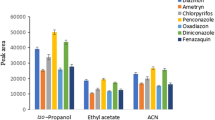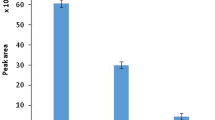Abstract
A simple, fast, and effective salt-assisted liquid-liquid extraction (SALLE) technique coupled with high-performance liquid chromatography (HPLC) was developed for determination of 2,4-dichlorophenoxyacetic acid (2,4-D) in water and edible seeds samples. Due to the polar nature of the 2,4-D molecules, LC analysis was performed on a CN stationary phase by using acetonitrile and acidic water as mobile phase. Extraction was achieved based on salting-out phenomenon. Affecting variables on the extraction efficiency of the 2,4-D, such as the solvent type and its volume, type of salt and its concentration, vortex time, and sample pH, have been investigated and optimized. The target analyte was successfully extracted by acetonitrile and sodium chloride as extracting solvent and salting-out agent, respectively. Under the optimized experimental conditions, calibration curve shows good linearity (r2 > 0.9957) and precision (RSD < 6.5%) in the concentration ranges of 1.0–10,000 ng/mL. The limit of detection (LOD) and limit of quantification (LOQ) were 0.3 and 1.0 ng/mL, respectively. The recoveries were in the range of 82.0–95.0 % with RSD values less than 7.2%. The method was successfully applied for the extraction and determination of 2,4-D in several edible seeds and water samples.







Similar content being viewed by others
References
Alesso M, Talio MC, Fernández LP (2017) Solid surface fluorescence methodology for fast monitoring of 2,4-dichlorophenoxyacetic acid in seed samples. Microchem J 135:60–65
Boivin A, Amellal S, Schiavon M, van Genuchten MT (2005) 2,4-Dichlorophenoxyacetic acid (2,4-D) sorption and degradation dynamics in three agricultural soils. Environ Pollut 138:92–99
Boroduleva AY, Eremin SA (2016) Determination of 2,4-dichlorophenoxyacetic acid in cereals by fluorescence polarization immunoassay. J Anal Chem 71:949–954
Haeri SA, Abbasi S (2016) Biocoacervation extraction combined with dispersive solid phase extraction using a reversed-phase core–shell magnetic molecularly imprinted sorbent for 2,4-dichlorophenoxyacetic acid prior to its determination by HPLC. J Iran Chem Soc 13:1993–1999
Heydari R (2012) Residual solvents determination in pharmaceuticals by static headspace-gas chromatography and headspace liquid-phase microextraction gas chromatography. Anal Lett 45:1875–1884
Heydari R, Azizi S (2015) Rapid monitoring and determination of class 1 residual solvents in pharmaceuticals using dispersive liquid-liquid microextraction and gas chromatography-mass spectrometry. J Chromatogr Sci 53:1020–1025
Heydari R, Darabi Bazvand MR (2019) Ultrasound-assisted matrix solid-phase dispersion coupled with reversed-phase dispersive liquid–liquid microextraction for determination of vitamin C in various matrices. Food Anal Methods 12:1949–1956
Heydari R, Mousavi M (2016) Simultaneous determination of saccharine, caffeine, salicylic acid and benzoic acid in different matrixes by salt and air-assisted homogeneous liquid-liquid extraction and high-performance liquid chromatography. J Chil Chem Soc 61:3090–3094
Heydari R, Zarabi S (2014) Development of combined salt- and air-assisted liquid-liquid microextraction as a novel sample preparation technique. Anal Methods 6:8469–8475
Heydari R, Rashidipour M, Naleini N (2014) Determination of efavirenz in plasma by dispersive liquid-liquid microextraction coupled to high-performance liquid chromatography. Curr Anal Chem 10:280–287
Heydari R, Hosseini M, Rezaeepour R (2017) Semi-automated salt-assisted liquid–liquid extraction coupled to high-performance liquid chromatography to determine three aromatic hydrocarbons in aqueous samples. J Iran Chem Soc 14:1691–1698
Heydari R, Lotfi Z, Ramezani M (2018) Simultaneous determination of zidovudine and lamivudine in plasma samples using miniaturized homogenous liquid–liquid extraction and high-performance liquid chromatography. J Anal Chem 73:1105–1110
Heydari R, Shakarami A, Kaykhaii M (2019) Determination of polycyclic aromatic hydrocarbons in soil samples using ultrasonic probe and salt-assisted liquid-liquid extraction coupled with high-performance liquid chromatography. J Chil Chem Soc 64:4332–4336
Heydarzadeh M, Givianrad MH, Heydari R, Aberoomand Azar P (2019) Salt-assisted liquid–liquid extraction in microchannel. J Sep Sci 42:3217–3224
Hosseini M, Heydari R, Alimoradi M (2014) Vortex and air assisted liquid-liquid microextraction as a sample preparation method for high-performed liquid chromatography determinations. Talanta 130:171–176
Hosseini M, Heydari R, Alimoradi M (2015) Reversed-phase vortex-assisted liquid-liquid microextraction: a new sample preparation method for the determination of amygdalin in oil and kernel samples. J Sep Sci 38:663–669
Hua MZ, Feng S, Wang S, Lu X (2018) Rapid detection and quantification of 2,4-dichlorophenoxyacetic acid in milk using molecularly imprinted polymers–surface-enhanced Raman spectroscopy. Food Chem 258:254–259
Ismaili A, Heydari R, Rezaeepour R (2016) Monitoring the oleuropein content of olive leaves and fruits using ultrasound- and salt-assisted liquid-liquid extraction optimized by response surface methodology and high-performance liquid chromatography. J Sep Sci 39:405–411
Jervais G, Luukinen B, Buhl K, Stone D (2008) 2,4-D Technical Fact Sheet; National Pesticide Information Center, Oregon State University Extension Services. http://npic.orst.edu/factsheets/archive/2,4-DTech.html. Accessed Dec 2019
Jia M, Zhang Z, Li J, Shao H, Chen L, Yang X (2017) A molecular imprinting fluorescence sensor based on quantum dots and a mesoporous structure for selective and sensitive detection of 2,4-dichlorophenoxyacetic acid. Sens Actuators B Chem 252:934–943
Mohammadnia M, Heydari R, Sohrabi MR (2020) Determination of 2,4-dichlorophenoxyacetic acid in food and water samples using a modified graphene oxide sorbent and high-performance liquid chromatography. J Environ Sci Heal B 55:293–300
Mohebbi M, Heydari R, Ramezani M (2017) Solvent-vapor-assisted liquid–liquid microextraction: a novel method for the determination of phthalate esters in aqueous samples using GC–MS. J Sep Sci 40:4394–4402
Pourghobadi Z, Heydari R, Pourghobadi R, Rashidipour M (2013) Determination of gabapentin in human plasma using simultaneous cloud point extraction and precolumn derivatization by HPLC. Monatsh Chem 144:773–779
Rashidipour M, Heydari R, Maleki A, Mohammadi E, Davari B (2019) Salt-assisted liquid–liquid extraction coupled with reversed-phase dispersive liquid–liquid microextraction for sensitive HPLC determination of paraquat in environmental and food samples. J Food Meas Charact 13:269–276
Reregistration Eligibility Decision (RED) (2005) 2,4-D; EPA 738-R-05-002; U.S. Environmental Protection Agency, Office of Prevention, Pesticides and Toxic Substances, Office of Pesticide Programs, U.S. Government Printing Office: Washington, DC
Rezaeepour R, Heydari R, Ismaili A (2015) Ultrasound and salt-assisted liquid-liquid extraction as an efficient method for natural product extraction. Anal Methods 7:3253–3259
Romero JM, Jorge NL, Grand A, Hernández-Laguna A (2015) Hydrolysis reaction of 2,4-dichlorophenoxyacetic acid. A kinetic and computational study. Chem Phys Lett 639:57–62
Sheng L, Jin Y, He Y, Huang Y, Yan L, Zhao R (2017) Well-defined magnetic surface imprinted nanoparticles for selective enrichment of 2,4-dichlorophenoxyacetic acid in real samples. Talanta 174:725–732
Skrzypczyńska K, Kuśmierek K, Świątkowski A (2016) Carbon paste electrodes modified with various carbonaceous materials for the determination of 2,4-dichlorophenoxyacetic acid by differential pulse voltammetry. J Electroanal Chem 766:8–15
United States Environmental Protection Agency (2009) National Primary Drinking Water Regulations. 〈https://www.epa.gov/ground-water-and-drinking-water/national-primary-drinking-water-regulations〉. Accessed Dec 2019
Wang X, Yu J, Wu X, Fu J, Kang Q, Shen D, Li J, Chen L (2016) A molecular imprinting-based turn-on ratiometric fluorescence sensor for highly selective and sensitive detection of 2,4-dichlorophenoxyacetic acid (2,4-D). Biosens Bioelectron 81:438–444
Wang QL, Li J, Li XD, Ding LS, Xie J, Qing LS (2017a) A simple nano-SiO2-based ELISA method for residue detection of 2,4-dichlorophenoxyacetic acid in Bean Sprouts. Food Anal Methods 10:1500–1506
Wang H, Wang J, Wang J, Zhu R, Shen Y, Xu Q, Hu X (2017b) Spectroscopic method for the detection of 2,4-dichlorophenoxyacetic acid based on its inhibitory effect towards catalase immobilized on reusable magnetic Fe3O4-chitosan nanocomposite. Sens Actuators B Chem 247:146–154
Wang H, Xu Q, Wang J, Du W, Liu F, Hu X (2018) Dendrimer-like amino-functionalized hierarchical porous silica nanoparticle: a host material for 2,4-dichlorophenoxyacetic acid imprinting and sensing. Biosens Bioelectron 100:105–114
World Health Organization (2011) Guidelines for drinking-water quality (4th ed.). 〈http://apps.who.int/iris/bitstream/10665/254637/1/9789241549950-eng.pdf?Ua=1〉. Accessed Dec 2019
Acknowledgments
The authors gratefully acknowledge the support of Razi Herbal Medicines Research Center, Lorestan University of Medical Sciences, Khorramabad (Iran).
Author information
Authors and Affiliations
Corresponding author
Ethics declarations
Conflict of Interest
Rouhollah Heydari declares that he has no conflict of interest. Rezvan Feyzianpour declares that he has no conflict of interest.
Informed Consent
Not applicable. This article does not contain any studies with human or animal subjects.
Additional information
This manuscript has not been published before and it is not under consideration for publication anywhere else.
Publisher’s Note
Springer Nature remains neutral with regard to jurisdictional claims in published maps and institutional affiliations.
Rights and permissions
About this article
Cite this article
Heydari, R., Feyzianpour, R. Determination of 2,4-Dichlorophenoxyacetic Acid in Water and Edible Seeds Samples Using Salt-Assisted Liquid-Liquid Extraction Coupled with High-Performance Liquid Chromatography. Food Anal. Methods 14, 561–567 (2021). https://doi.org/10.1007/s12161-020-01903-3
Received:
Accepted:
Published:
Issue Date:
DOI: https://doi.org/10.1007/s12161-020-01903-3




